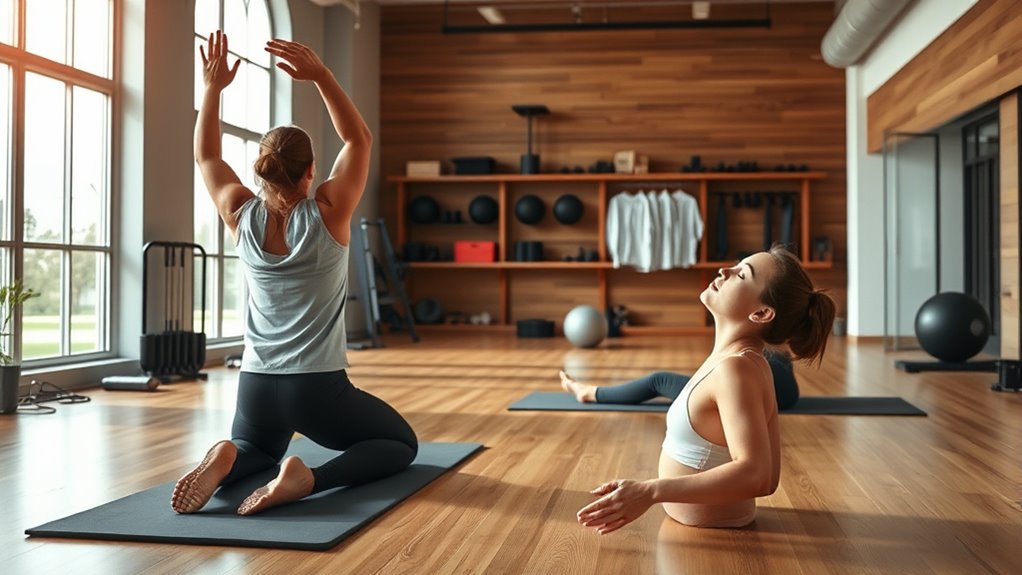A proper warm-up and cool-down routine helps you perform better, prevent injuries, and recover faster. Your warm-up should include dynamic stretches and light cardio to loosen muscles and increase blood flow. After exercising, static stretching and foam rolling help your muscles relax and recover. Tailoring these routines to your workout type and maintaining consistency will make them effective. Keep exploring to learn tips for building habits and optimizing your routines for lasting benefits.
Key Takeaways
- Incorporate dynamic stretches and light cardio to gradually raise heart rate and loosen muscles before exercise.
- Use static stretches post-workout to improve flexibility and aid muscle recovery.
- Tailor warm-up and cool-down routines to specific activity types for maximum effectiveness and injury prevention.
- Maintain consistency with routines, including hydration and foam rolling, to support recovery and overall fitness progress.
- Use cues like music or workout gear to establish habits and ensure routines are performed regularly and effectively.
The Benefits of Proper Warm-Up and Cool-Down Practices

A proper warm-up and cool-down routine can considerably enhance your overall workout experience. When you warm up correctly, you improve muscle elasticity, making your muscles more flexible and responsive. This flexibility reduces the risk of strains or tears during intense activity. A good warm-up gradually increases blood flow, preparing your body for exercise and helping you perform better. Cooling down helps your muscles relax and recover, which is essential for injury prevention and reducing soreness. It also helps clear metabolic waste from your muscles, preventing stiffness. Additionally, incorporating proper recovery techniques can further optimize your fitness results. By incorporating these practices into your routine, you not only boost your performance but also protect your body from unnecessary harm. Consistent warm-up and cool-down sessions are key to maintaining a healthy, sustainable fitness journey.
Key Components of an Effective Warm-Up Routine

To create an effective warm-up routine, focus on gradually increasing your heart rate and loosening up your muscles. Key components include dynamic movements that promote muscle activation, preparing your body for activity. Incorporate activities like jogging, leg swings, or arm circles to engage multiple muscle groups and improve circulation. This process helps loosen tight muscles, which reduces the risk of injury during your workout. Make certain your warm-up is specific to your activity; for example, if you’re running, include light jogging or strides. Proper muscle activation enhances performance and supports injury prevention by making muscles more responsive and less prone to strains. A well-structured warm-up primes your body, making your workout safer and more effective from the start. Additionally, understanding the importance of injury prevention underscores the value of a proper warm-up routine.
Essential Cool-Down Techniques to Aid Recovery

Cooling down after your workout is essential for recovery and injury prevention. It helps gradually bring your heart rate back to normal and reduces muscle stiffness. Incorporate post-exercise nutrition, like a protein-rich snack, to support muscle repair and replenish energy stores. Foam rolling is also a valuable cool-down technique; it releases muscle tightness, improves circulation, and enhances flexibility. Spend a few minutes rolling out major muscle groups to reduce soreness and promote faster recovery. Remember, the goal is to ease your body out of intense activity, not to push further. Combining proper nutrition with foam rolling ensures your muscles recover effectively and stay healthy, preparing you for your next workout. Prioritize these techniques to maximize recovery and prevent injuries. Engaging in mindful relaxation techniques can further aid in spiritual energy and overall well-being.
How to Incorporate Dynamic and Static Stretches

Incorporating dynamic stretches before your workout helps prepare your muscles for activity, while static stretches afterward enhance flexibility and aid recovery. You should focus on performing dynamic movements like leg swings or arm circles during warm-up, and hold static stretches such as hamstring or shoulder stretches during cool-down. Understanding how to balance these techniques maximizes your workout benefits and reduces injury risk. Incorporating scenic views and charming local shops can make your stretching routine more enjoyable and motivating.
Dynamic Stretching Techniques
Dynamic stretching is an effective way to prepare your muscles for exercise by actively moving through a range of motion. To incorporate it effectively, focus on exercises that mimic your workout movements, such as leg swings, arm circles, or walking lunges. These techniques promote muscle activation, helping your muscles warm up and become ready for activity. Use controlled, deliberate motions to avoid overstretching or injury. Dynamic stretches increase blood flow and improve joint mobility, which can help prevent injuries during your workout. Incorporate these stretches into your warm-up routine, performing each movement for about 10-15 repetitions or 30 seconds. Consistently practicing dynamic stretching helps your body transition smoothly into more intense exercise, enhancing performance and reducing the risk of strain. Additionally, understanding the role of proper warm-up routines can further optimize your exercise preparation.
Static Stretching Benefits
Static stretching offers several benefits when integrated into your warm-up and cool-down routines, especially after your muscles are already warmed up. It helps improve muscle elasticity, making your muscles more flexible and responsive. Additionally, static stretching can aid in injury prevention by reducing muscle tension and decreasing the risk of strains. To maximize these benefits, incorporate static stretches carefully and hold each stretch for about 15-30 seconds. Here are some ways static stretching can help you:
- Increase flexibility and range of motion for better performance
- Reduce muscle soreness post-exercise
- Promote relaxation and recovery by calming the nervous system
- Embrace the spirit of discovery by exploring new ways to enhance your flexibility and overall fitness.
Common Mistakes to Avoid During Warm-Up and Cool-Down

One common mistake during warm-up and cool-down is rushing through these routines or skipping them altogether. When you do this, you increase the risk of overstretching injuries, which happen when muscles are not properly prepared or cooled down. Another mistake is neglecting hydration, which can lead to dehydration and muscle cramps. Avoid jumping into intense activity right away—take time to gradually increase your heart rate and loosen muscles. Similarly, don’t skip the cool-down, as it helps reduce muscle stiffness and flush out lactic acid. Rushing through these steps shortchanges your recovery and increases injury risk. Be mindful to dedicate enough time, stay hydrated, and perform a balanced, gradual routine to protect your body and optimize your workout results. Incorporating proper warm-up and cool-down techniques can significantly enhance your overall exercise safety and effectiveness.
Tailoring Routines for Different Types of Exercise

When customizing your warm-up and cool-down, consider the type of exercise you’re doing. For cardio, dynamic stretches help prepare your muscles, while static stretches are better for post-workout recovery. Strength routines may require different approaches, so adjusting your routine guarantees you get the most benefit without risking injury. Incorporating appropriate emotional support can also enhance your exercise experience and motivation.
Dynamic vs. Static Stretches
Choosing the right type of stretch depends on your workout goals and the activity you’re about to do. Dynamic stretches are ideal for warming up because they promote muscle activation and prepare your body for movement. They involve active movements that increase blood flow and enhance flexibility temporarily. Static stretches, on the other hand, are better suited for cooling down, helping to gradually relax muscles and improve long-term flexibility. To make the most of your routine:
- Use dynamic stretches before exercise to activate muscles and prepare joints.
- Incorporate static stretches after workouts to promote flexibility enhancement.
- Avoid static stretches during warm-up, as they may reduce muscle activation and performance.
- Incorporating sports-specific tuning can help optimize performance and recovery strategies.
Selecting the appropriate stretch type ensures you optimize your warm-up and cool-down, reducing injury risk and improving overall efficiency.
Cardio vs. Strength Routines
Ever wonder why your warm-up routines should differ depending on whether you’re doing cardio or strength training? For cardio, focus on gradually increasing your heart rate with light activity, incorporating interval training to boost blood flow and prepare your muscles. This helps with muscle activation and improves endurance. When preparing for strength routines, prioritize dynamic moves that target specific muscle groups you’re about to work. This enhances muscle activation, reduces injury risk, and increases performance. Warm-ups for strength should include movements like bodyweight squats or arm circles to activate key muscles. Tailoring your warm-up ensures your body is ready for the demands of each exercise type, improving results and reducing injury chances. Incorporating exercise-specific warm-ups can further optimize your preparation and performance. Adjust your routine to match your workout for excellent performance and safety.
Practical Tips for Making These Routines a Habit

Forming a habit of warming up and cooling down regularly requires intentionality and simple strategies. To stick with these routines, prioritize mental focus by setting clear intentions each time you exercise. Incorporate hydration strategies by drinking water before and after workouts to stay energized. Keep your routines consistent by scheduling them at the same time daily, making them an automatic part of your workout. Use cues like a specific playlist or workout gear to remind yourself. Track your progress to stay motivated. Finally, remind yourself of the benefits—improved performance, reduced injury risk, and quicker recovery—to reinforce the habit. Additionally, understanding the contrast ratio of your projector can help you optimize your viewing environment for the best experience. With these practical tips, warming up and cooling down will become second nature, supporting your overall fitness journey.
Frequently Asked Questions
How Long Should Each Warm-Up and Cool-Down Session Last?
You should aim for a warm-up and cool-down session of about 5 to 10 minutes each. Duration guidelines suggest personalized timing based on your workout intensity and fitness level. A warm-up should gradually increase your heart rate and loosen muscles, while a cool-down helps your body recover and reduces soreness. Adjust these times as needed, listening to your body’s signals for ideal preparation and recovery.
Can Warm-Up and Cool-Down Routines Prevent Injuries Effectively?
Warm-up and cool-down routines are your first line of defense in injury prevention and exercise safety. They prepare your body like a well-oiled machine, reducing strain and easing recovery. By gradually increasing and decreasing intensity, you lower the risk of strains, sprains, and muscle pulls. Incorporating these routines consistently makes your workouts safer and helps you stay active longer, turning exercise into a safe, enjoyable journey rather than a risky gamble.
Are There Specific Exercises Suitable for All Fitness Levels?
Yes, there are exercises suitable for all fitness levels. As a beginner, you can start with simple activities like walking or gentle stretching. If you’re more advanced, you can incorporate higher-intensity movements or advanced modifications to challenge yourself. The key is to listen to your body and adjust exercises accordingly. Whether you’re new or experienced, choosing appropriate exercises helps you stay safe and progress comfortably.
When Is the Best Time to Perform Warm-Up and Cool-Down?
You should perform warm-up exercises right before your workout and cool-down activities immediately afterward. Timing considerations are key; do them just before and after to prevent injury and aid recovery. Seasonal adjustments matter too—warm-up longer in cold weather to prepare your muscles, and cool down gradually in hot weather to avoid dizziness. Incorporate these routines consistently for ideal results and safety during all seasons.
How Do I Modify Routines for High-Intensity Versus Low-Intensity Workouts?
Think of your workout as a journey—high-intensity like a sprint, low-intensity like a leisurely walk. For high-intensity, you need dynamic stretching and muscle activation to prepare quickly and prevent injury. For low-intensity, ease into it with gentle movements and longer cool-downs. Adjust your routines by increasing or decreasing warm-up intensity, focusing on specific muscle groups, and extending cool-downs to match your workout’s effort level.
Conclusion
Think of your warm-up and cool-down as the opening and closing chapters of your fitness story. They set the tone, protect your body, and help you recover stronger. When you embrace these routines, you’re nurturing a garden of strength and resilience, allowing your muscles to bloom and rest in harmony. Make these moments a sacred part of your workout, and you’ll find your progress blossoming with each session.









